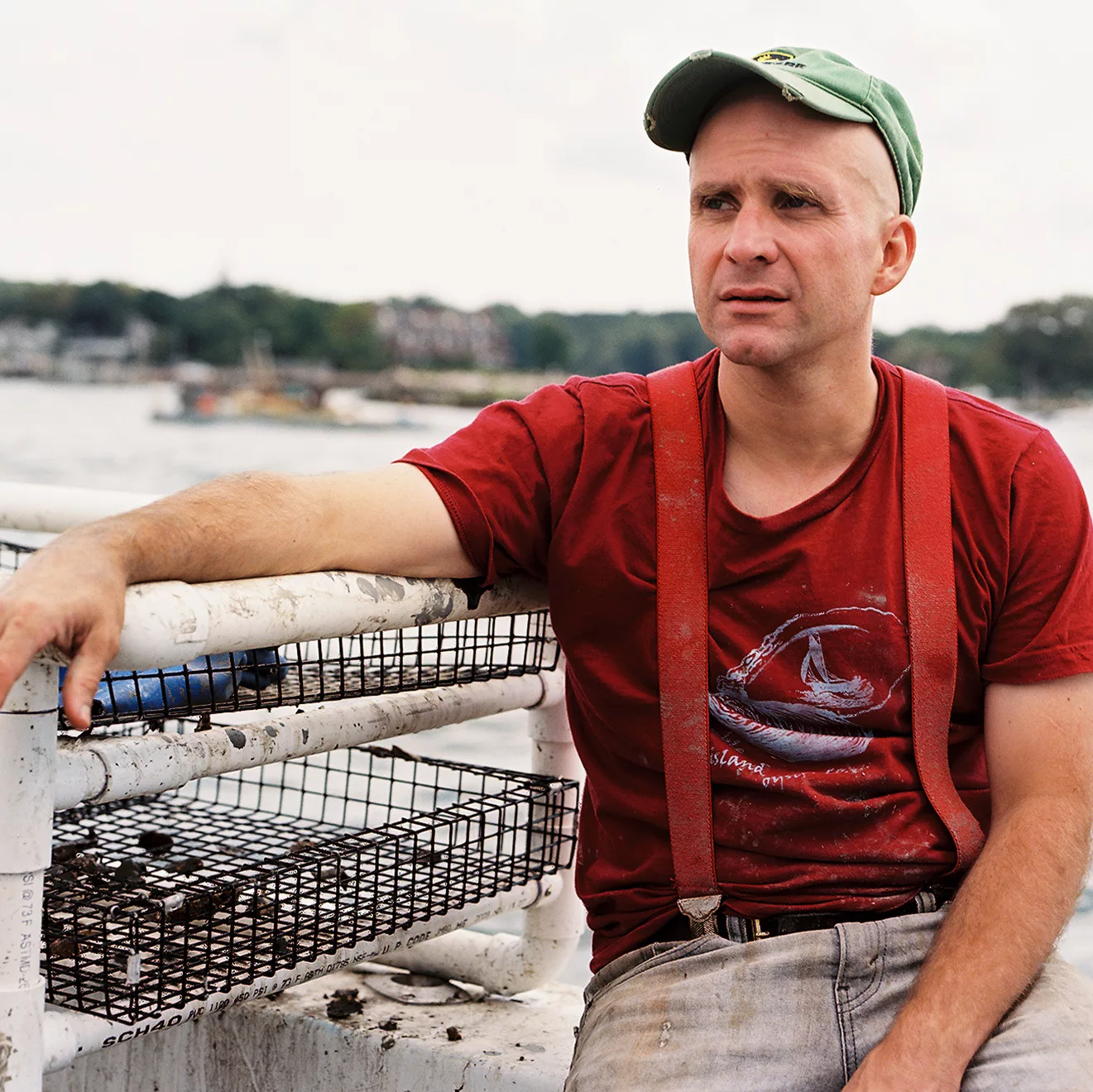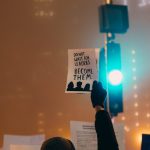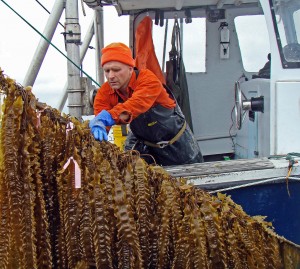 Bren Smith is a lifelong fisherman with a passion for improving the health of our oceans and an entrepreneurial vision for creating positive global change. He describes his journey from commercial fisherman to restorative ocean farmer as one of “ecological redemption.” Smith’s Thimble Island Oyster Farm was the world’s first sustainable 3D ocean farm. His method of farming uses the full water column to grow nutritious food while repairing damaged marine ecosystems, mitigating climate change, and building a new blue-green economy. Now, as Executive Director of nonprofit organization GreenWave, Smith is training a new generation of ocean farmers and constructing the necessary infrastructure to replicate and scale this model globally.
Bren Smith is a lifelong fisherman with a passion for improving the health of our oceans and an entrepreneurial vision for creating positive global change. He describes his journey from commercial fisherman to restorative ocean farmer as one of “ecological redemption.” Smith’s Thimble Island Oyster Farm was the world’s first sustainable 3D ocean farm. His method of farming uses the full water column to grow nutritious food while repairing damaged marine ecosystems, mitigating climate change, and building a new blue-green economy. Now, as Executive Director of nonprofit organization GreenWave, Smith is training a new generation of ocean farmers and constructing the necessary infrastructure to replicate and scale this model globally.
In 2013, Smith was selected for a SOCAP Entrepreneur Scholarship and contributed to the SOCAP Oceans content track. Since then he has been named an Ashoka Fellow, an Echoing Green Climate Fellow, and his work has won accolades from the Clinton Global Initiative. The Buckminster Fuller Institute (BFI) named GreenWave as winner of the 2015 Fuller Challenge, socially responsible design’s highest honor and a $100,000 prize. Elizabeth Thompson, Executive Director of BFI, described GreenWave’s solution as “a scalable, integrated model that coastal fishing communities around the world can adopt with modest infrastructure costs and begin to build towards a long-term resilient future.” We spoke with Bren Smith about the health of our oceans, the coming age of kelp, the evolution of aquaculture, and the current and future impact of GreenWave.
SOCAP: When the SOCAP community first met you in 2013, you were creating impact on your own farm. Now, through GreenWave you are training others to become 3D ocean farmers. Was there a lightbulb moment when you realized that GreenWave was the evolution necessary to help your idea scale globally?
Bren Smith: Yes. It took 15 years of experimenting out on the water with lots of failures (laughs). Once the model came together, I did a Kickstarter campaign to enable me to scale up. We raised $40,000 to triple the size of the farm, but the money became secondary. The idea exploded. Interest came from all different sectors: architecture, venture capital in Silicon Valley, folks interested in carbon trading, government officials, everybody.
“I realized that the answer wasn’t becoming the king of kelp. It was helping thousands of new ocean farmers grow food, capture carbon, and create jobs in local communities. That felt like my life’s work.”
Investors were coming to me with offers of significant sums of money, telling me to create a brand and become ‘the Kelp King.’ I had to do some soul searching. I asked myself, “What accomplishment would let me die happy?” I realized that the answer wasn’t becoming the king of kelp. It was helping thousands of new ocean farmers grow food, capture carbon, and create jobs in local communities. That felt like my life’s work.
GreenWave spun off at that moment, with the mission to train farmers, replicate and scale the model, create the infrastructure, and develop the market for this new industry.
Buckminster Fuller created human centered, elegant solutions for complex problems and your model really fits that. Can you speak a bit about what you’ve learned from Fuller’s work and the impact of winning the BFI challenge?
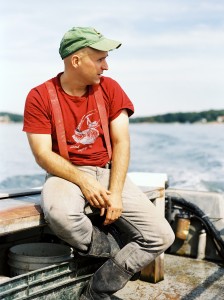 I’m inspired by Buckminster Fuller’s work in all its brilliant forms, but particularly the idea of designing with Mother Nature’s technologies as the core principle. Designing with elegance and simplicity–that is the engine of replication and scale. The geodesic dome is, in its DNA, designed to be replicated. That is a tradition that we are overjoyed to be associated with.
I’m inspired by Buckminster Fuller’s work in all its brilliant forms, but particularly the idea of designing with Mother Nature’s technologies as the core principle. Designing with elegance and simplicity–that is the engine of replication and scale. The geodesic dome is, in its DNA, designed to be replicated. That is a tradition that we are overjoyed to be associated with.
I am completely honored to try to take Fuller’s vision of ecological design out into our unexplored seas. The crises facing our oceans and our food system make this a particularly crucial time to do it. We were able to immediately put the BFI Challenge award money into our farmer training program to get ten new farms in the pipeline, to build a hatchery, and we are in the process of building the country’s first seafood hub. Once the farmers’ crops hit the docks, we’ll be able to process it.
The BFI Challenge jump-started all the ideas we had, all the energy we had. It was just the infusion we needed to make it real. We got two million hits on our website last month–that has happened multiple times now. We have people that want to start farms in every coastal state and 62 countries. It is total madness. Our job now is to figure out the model that will allow this to replicate again and again. That is going to be the challenge going forward.
Is there a call to action you would like to issue to the SOCAP community?
Because the oceans are unexplored from a sustainable farming perspective, this is our chance to do food right, to do agriculture right, to learn from – and not replicate – the failures. There is also incredible opportunity in the new market that’s being created. To make it a successful industry, we need a hybrid of non-profit and for-profit support: non-profit support for training farmers and giving them the tools and instruction they need to scale up their farms up very, very quickly; and for-profit support with the product development, to take what we are growing in the ocean and capture the value in the supply chain — kelp noodles, soups, biofuel.
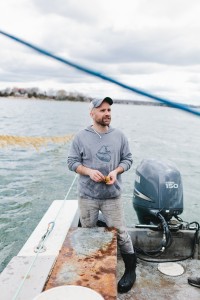 The farmers have to learn to grow, and growing food is hard. It takes a lot of skill and a lot of time. That is their job. The job for the market development and investment community is to play that intermediary so the farmers can focus on growing. The two can’t happen without each other.
The farmers have to learn to grow, and growing food is hard. It takes a lot of skill and a lot of time. That is their job. The job for the market development and investment community is to play that intermediary so the farmers can focus on growing. The two can’t happen without each other.
At SOCAP13, I heard from a lot of investors that the investment community recognizes that we need solutions in our oceans, but it is too early and too risky for people to invest. This is why we need a non-profit sector to lay the groundwork, so the for-profit sector can come in and really develop the marketplace.
If people are looking for direct opportunities to support GreenWave, we are looking for people to sponsor farmers all over the country right now. In our Farm Startup and Apprenticeship program, farmers get two years of training, free seed, free gear from Patagonia, and we guarantee to buy 80% of their crops for five years above market rate so they can really stabilize. There is opportunity to directly support farmers in this program, so if someone wants to sponsor a farmer, they should contact GreenWave and we’ll find a farmer that’s a good fit for them.
In a recent New Yorker article about the coming age of seaweed, you spoke about partnerships you are building within the restaurant industry to develop a new cuisine based on sea vegetables. Will you describe some of the ways in which you are working to boost demand in the marketplace for the foods your ocean farmers are growing?
We are trying to do something very difficult, which is to rearrange the seafood plate and put bivalves and ocean plants in the center and wild fish at the edges. Traditionally, aquaculture has tried to replicate a wild fishery palate by farming salmon and tuna, but it’s not sustainable. We need to learn to eat what the oceans can provide at this point, and shift tastes in that direction. We grow it, and it is up to the chefs to use their brilliance and creativity to make it delicious.
“Traditionally, aquaculture has tried to replicate a wild fishery palate by farming salmon and tuna, but it’s not sustainable. We need to learn to eat what the oceans can provide at this point, and shift tastes in that direction. We grow it, and it is up to the chefs to use their brilliance and creativity to make it delicious.”
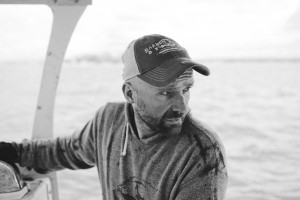 We are going to be eating seagreens in the future. As climate change worsens, and with the growing water crisis, the price of food is going to increase. Because this crop requires zero inputs—no freshwater, no fertilizer, no feed – seagreens will become the most affordable and most sustainable food on the planet. But will it be like drinking cod liver oil or will it be delicious food? That is up to our chefs. One of the chefs in the New Yorker piece, Brooks Headley, comes out of the pastry world and brings a completely new eye to ocean cuisine. His barbecue kelp noodles with parsnips and breadcrumbs sell out all the time because it’s more like a vegetable than a seafood dish.
We are going to be eating seagreens in the future. As climate change worsens, and with the growing water crisis, the price of food is going to increase. Because this crop requires zero inputs—no freshwater, no fertilizer, no feed – seagreens will become the most affordable and most sustainable food on the planet. But will it be like drinking cod liver oil or will it be delicious food? That is up to our chefs. One of the chefs in the New Yorker piece, Brooks Headley, comes out of the pastry world and brings a completely new eye to ocean cuisine. His barbecue kelp noodles with parsnips and breadcrumbs sell out all the time because it’s more like a vegetable than a seafood dish.
“There are 10,000 edible plants in the sea, and we only know how to grow a couple right now. There is incredible opportunity for resources to come into this space and discover the equivalent of arugula, corn, or tomatoes for the first time in the ocean.”
But this isn’t just about kelp. Kelp is our on-ramp, not only into an entirely new way of thinking about our oceans, but also a source of new food opportunities. There are 10,000 edible plants in the sea, and we only know how to grow a couple right now. There is incredible opportunity for resources to come into this space and discover the equivalent of arugula, corn, or tomatoes for the first time in the ocean.
Think about the excitement, from a chef’s perspective, of discovering literally thousands of new ingredients.
Dana (Goodyear) wrote this brilliant line in that New Yorker piece: “kelp is the culinary equivalent of an electric car.” It captures so well the multidimensional aspect of the future of seaweed. We can take every bit of those plants and find somewhere on the value chain to put them with zero waste. Food is at the top of the chain, followed by animal feed, pet food, and skincare products. Fertilizer and biofuel come at the bottom. Dana captured the potential and power of kelp in that statement.
How are you measuring GreenWave’s economic, food security, and environmental impacts?
One metric is volume of food per acre. We can grow 30 tons of seaweed and a quarter of a million shellfish per acre, with zero inputs, with the right design. In terms of food security, our goal is to increase production per acre, but in a sustainable way.
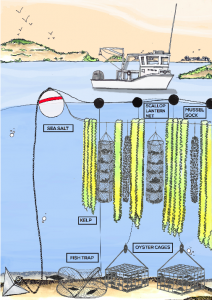 We also consider the number of different kind of species we can grow. It’s about volume but also about diversity and variation. This isn’t about monoculture. We track restoration by doing species counts on the farm to see how many new species and the volume of new species per acre that are returning. Over 150 species are attracted to these farms, these thriving ecosystems. You go 100 yards away and find muddy patches of nothing.
We also consider the number of different kind of species we can grow. It’s about volume but also about diversity and variation. This isn’t about monoculture. We track restoration by doing species counts on the farm to see how many new species and the volume of new species per acre that are returning. Over 150 species are attracted to these farms, these thriving ecosystems. You go 100 yards away and find muddy patches of nothing.
In addition to species restoration, we use carbon and nitrogen sequestration as a measure of our environmental impact. We are calculating how much carbon we are sequestering and how much nitrogen we are soaking up.
Job creation is another important metric. One of our farms creates about five full time jobs and about fifteen part time jobs. That doesn’t even count all the economic activity that spins out of related startups.
We have a triple bottom line approach, and we truly believe our model can provide environmental, economic, and social benefits. We’re trying to ensure that people are making a great living while addressing food security and climate change, some of the major crises of our time.
Where does GreenWave hope to be 10 years from now? What are your projections?
Our vision is to have 25 to 50 farms in a region, clustered around a seafood hub, with stable regional buyers—hospitals, universities, large companies, and restaurants – purchasing all the farmers’ goods. I think of them as GreenWave “reefs,” and we want them replicated every 150 miles up our coastlines. This year we will have the first GreenWave reef completely set up and finished here in Southern New England. We’ve already started to move into two new regions: the Pacific Northwest and California. In ten years, I hope that we have ten GreenWave reefs around the country. We’ll be expanding internationally, too. We’re exploring projects in Trinidad and Tobago and have been invited to be part of new projects in Europe.
Expansion isn’t limited to just GreenWave reefs. Because we’re creating an open-sourced manual, individuals can use that to create farms on their own. This will be a valuable metric of our success – the number of farmers that are able to get started using just the resources in the manual. That is how we are going to scale quickly and we are already seeing it happen.
What advice do you have for any entrepreneurs who want to make a positive impact? Do you have any wisdom to share that you wish someone had given you when you were starting out?
“Your greatest strength early on is in failing, pivoting, trying again, and again, and again. Very often, if you take investment too early that locks you into a strategy.”
For me, it was to not take money too early. Your greatest strength early on is in failing, pivoting, trying again, and again, and again. Very often, if you take investment too early that locks you into a strategy.
We all get really excited because when you start getting investment it means you are gaining momentum and are headed down the road to success. If you are in an industry that is in its infancy and there are a lot of unknowns, incubate yourself in experimentation. Hold off on the money for a while. We said no to significant investment for about 5 years and had the freedom to fail until we got it right.
What is inspiring you in your work right now?
The huge challenges we face as a planet – climate change, food insecurity, unemployment – and to see people excited about starting their own farms and businesses to fight these challenges in their own way. We have interest from all kinds of folks – unemployed fisherman, students, inner-city families – and it is so inspirational.
Resources
- Bren Smith’s talk at TEDxBermuda 2013: 3D Ocean Farming -The Least Deadliest Catch
- Buckminster Fuller Institute’s online project profile on GreenWave
- Bren Smith’s Ashoka Fellow profile
- Dana Goodyear’s New Yorker article on seaweed, A New Leaf
- David Brancaccio interview with Bren Smith for Marketplace
- Scientific American: Move Over, Kale, The New Super Vegetable Comes From The Sea
Apply for the BFI Challenge
Applications are being accepted for the 2016 Buckminster Fuller Challenge from now til March 1, 2016. Submit your application to the BFI Challenge here.
Stay Updated
Subscribe here!
Photo credit for all Bren Smith images: Ron Gautreau
